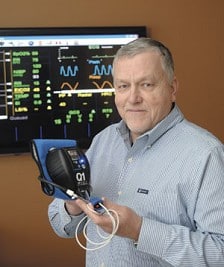Athena GTX gains foothold in first-responder market

Athena GTX has spent the past several years developing emergency medical monitoring devices for the U.S. military. Now, as military contracts fuel the Des Moines company’s growth, civilian medical centers have begun testing its devices for use by emergency medical responders.
The biomedical technology company anticipates significant growth in the next several years as it rolls out products that experts say will play a large role in the evolution of emergency medicine.
“The market of first-responder medicine did not have a recession,” said Mark Darrah, president and CEO of Athena GTX, who moved the start-up company from Southern California to Des Moines in 2007. Since the Business Record first wrote about Athena GTX in December 2007, the company has grown to 20 employees. Darrah expects to at least double that figure in the next four years as its products move from the research and development stage into production.
Athena’s Wireless Vital Signs Monitor (WVSM) enables emergency medical responders to remotely monitor a patient’s heart rate, blood pressure and other indicators and instantaneously relay that data while the patient is en route to the hospital. Weighing less than a pound and a little larger than a cordless telephone, the device was initially designed for use by U.S. special forces teams. The company began selling the devices to both military and civilian customers at the beginning of the year.
“Once we achieved FDA (U.S. Food and Drug Administration) clearance of (the WVSM) last summer, things have really taken off,” Darrah said. “We’re building a backlog already.”
Military origins
Among the first civilian patients on whom the WVSM was used was Rep. Gabrielle “Gabby” Giffords. The Arizona congresswoman wore the device when she was transported from Tucson to Houston for medical treatment in January, after being critically wounded by a gunman. Giffords’ physician, Dr. Peter Rhee, participated in the testing of the device for the Office of Naval Research (ONR).
“Since it is now FDA-approved, we were able to transport her with this device in place,” Rhee, trauma medical director at University Medical Center in Tucson, said in a video released last week by the ONR. “So the physicians and nurses that were accompanying her were able to easily monitor her without having her attached to a lot of wires.”
Rhee, who served 24 years as a surgeon in the Navy, observed the need for a more lightweight, portable device while serving in Afghanistan in 2003. In 2007, Athena GTX received a $2.3 million federal appropriation to develop the WVSM.
The device will be valuable to both the military and civilian markets, said Dr. Timothy Bentley, deputy of the ONR’s Force Health Protection Future Naval Capability, which coordinated development of the WVSM for military use.
“The fact that it’s wireless, that means that you don’t have a large number of wires going between the patient and the monitor,” Bentley said in the ONR video. “It makes it much easier to transport the patient without snagging these cords on something. It’s particularly important in a field environment where it’s rough and there’s equipment all over the place and it’s sometimes almost frantic.”
In the civilian market, “it will find plenty of usage, I believe, in ambulances, in air transport and even within civilian hospitals for patient movement,” he said.
Normally, the process of obtaining FDA approval for a new medical device can take six months or more, “but because of our ties to special forces, it was cleared in 30 days,” Darrah said. “Developing products for the military market and then transitioning them to the civilian market has been a pretty good business model for us.”
Three other wireless monitoring devices developed by Athena are undergoing clinical trials at medical centers across the country. One of those devices, the Mini-Medic, is a smaller version of the WVSM that Athena designed for use by the military’s special forces units that attaches to a patient’s forehead. Athena expects to receive FDA clearance for that device this fall.
Another of its products, called WiSync, is a wireless device to which emergency responders can connect medical devices to interface with hospitals’ communications networks. A fourth device, known as the Dogbone because of its shape, is a compact wireless physiological monitoring system designed to be worn by soldiers or emergency workers to track their vital signs.
Hospital interest
Athena’s flagship WVSM device has caught the attention of some major medical research institutions, among them Vanderbilt University Medical Center in Nashville, Tenn. A surgical response team from Vanderbilt is currently using 10 of the WVSM devices to treat patients in Haiti.
“They came to us because they were familiar with us from our California work,” Darrah said. That contract led to interest from Cleveland Clinic in Ohio, which has begun a clinical study to test the use of the WVSM for monitoring patients following heart surgery.
Because of the high cost of traditional heart monitors, patients aren’t routinely monitored after surgery, said Greg France, Athena’s director of sales and integrated marketing. However, the WVSM’s relatively low cost – about $5,250 per unit – may enable that to be done more frequently, he said. Prior to Cleveland Clinic’s inquiry, using the system for post-operative monitoring, rather than only during treatment by emergency responders, was “something we never even considered,” France said.
Additionally, “since the unit goes on a person, they can go all around the hospital without having to push a heavy console on a pole with them,” he said.
In Des Moines, Iowa Methodist Medical Center is considering testing the device in a clinical trial at its trauma center, and the hospital’s Life Flight helicopter team is also testing it for possible use.
“We’re excited to partner with (Athena GTX) as their wireless technologies evolve,” said Michael Zweigart, Life Flight’s manager. “It would really simplify our lives in the air-medical community.”
Life Flight crews are currently testing a demonstration unit and receiving instruction from the company before the device can be used in the aircraft. Crews must also determine that the wireless signals won’t interfere with the helicopter’s communications equipment.
“Our hope is to establish its usefulness and then to start to use it on our daily patients,” Zweigart said.
Interest in the WVSM has come from as far away as Sao Paulo, Brazil, where medical teams are testing the device for use by medics on mopeds and bicycles to reach traffic accident victims on the city’s often gridlocked highways.
In Melbourne, Australia, a medical center is working to incorporate a decision-software product it developed for trauma physicians into Athena GTX’s WiSync device. The medical center’s administrators had seen a demonstration of the company’s devices at an international trade show held last year in Florida.
“They were enamored with the idea that a mobile platform could link to anybody’s medical product,” Darrah said. “They want to put their computerized decision support into our product. The computer isn’t making decisions; it’s just advising the trauma team what they might want to think about or what they might have missed. They’ve already shown the efficacy of that software in thousands of patients; they saw a huge reduction in errors.”
Creating jobs
Besides attracting new customers, Athena GTX has established a solid base of clients, Darrah said.
“We’re looking at $500,000 to $1 million in commercial sales on just this (WVSM) product in the next 12 months,” he said. And for the military, the company has locked in an order for at least 800 WVSMs within the next 16 months. “That alone is more than $2.3 million in sales revenue from one product, so we’re absolutely ecstatic about that,” he said.
Darrah, who has a master’s degree and doctorate in biomedical engineering from Iowa State University, left the state more than 25 years ago because he was unable to find work in Iowa. Since moving back to the state, his company has become a job creator in this highly specialized field.
In the past four years, the company has provided internships for 16 biomedical engineering students through the Iowa Department of Economic Development’s Student Internship Program, and so far has hired four of those students following graduation.
Though it also maintains offices in Texas and California, Athena GTX is now in the process of consolidating the majority of its operations to Des Moines. In addition to moving all of its engineers to Des Moines, the company also shifted its intellectual property and legal work to the Davis Brown Law Firm in Des Moines, and has hired Clifton Gunderson LLP in West Des Moines for its accounting work.
“It looks like we’re here to stay, and the growth looks pretty promising,” Darrah said. “It’s because the market hasn’t gone away; if anything, it’s gotten more demanding in the past three years.”
To view a video of Athena GTX click here.










